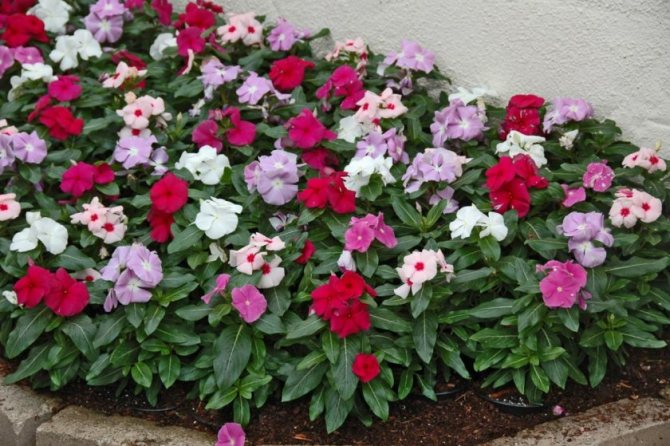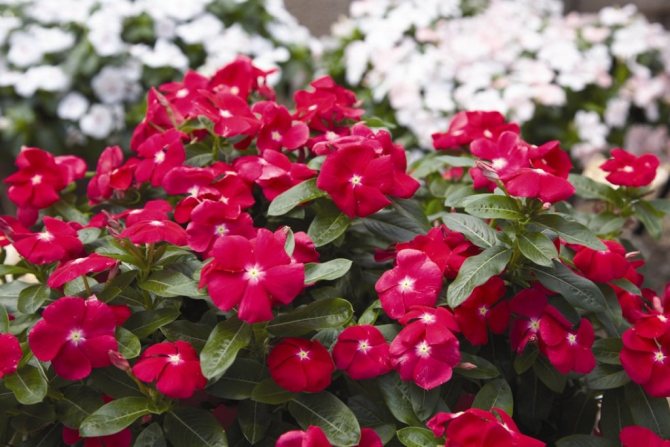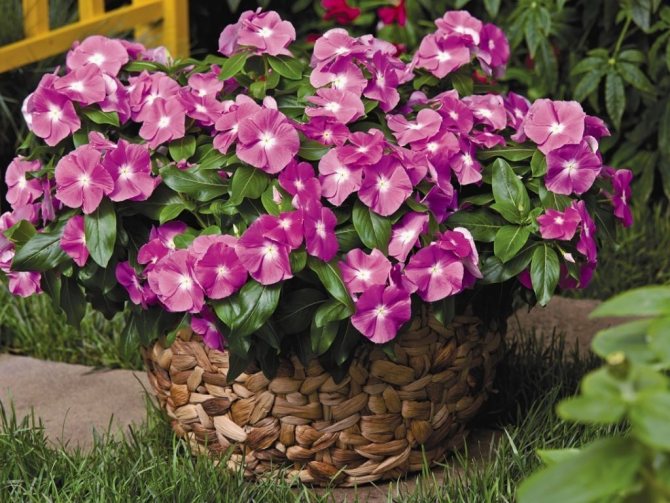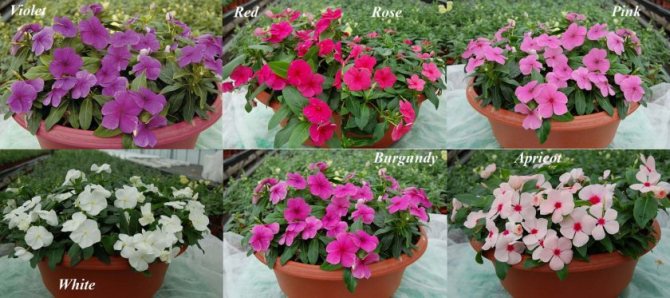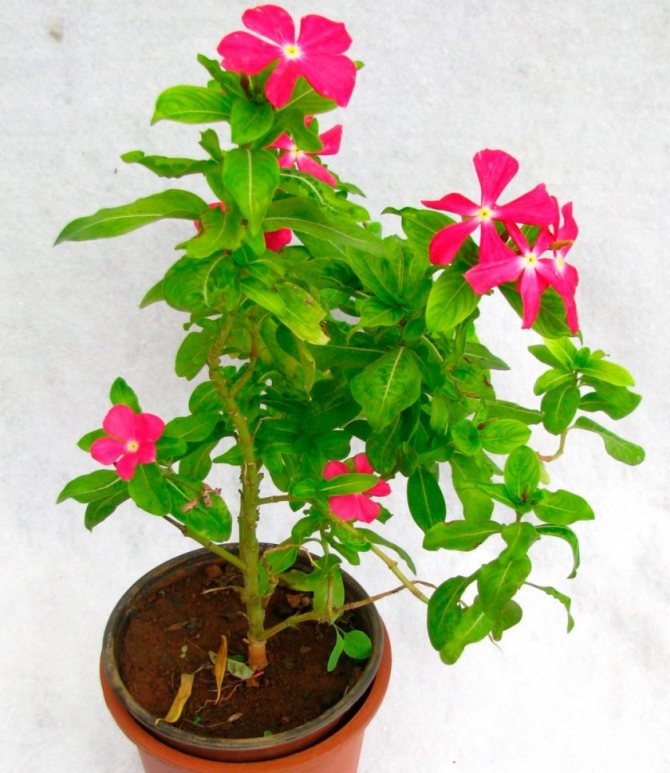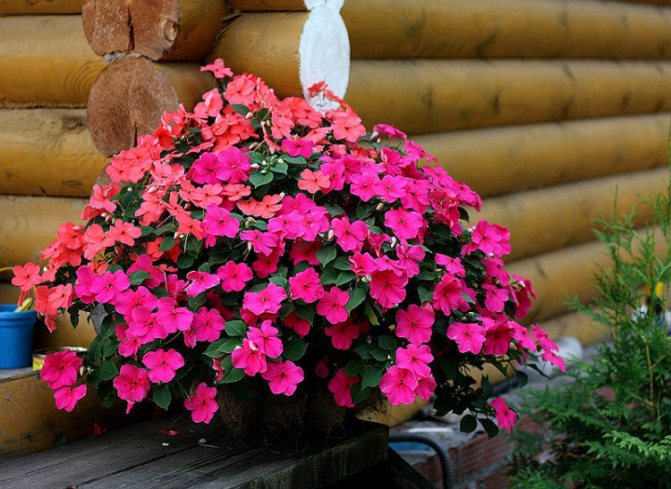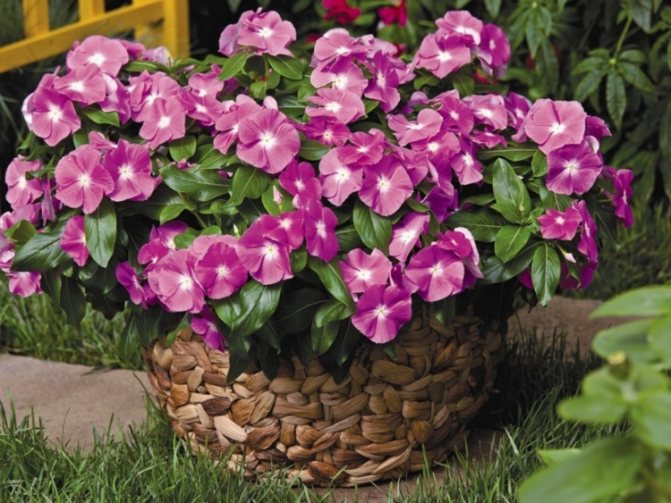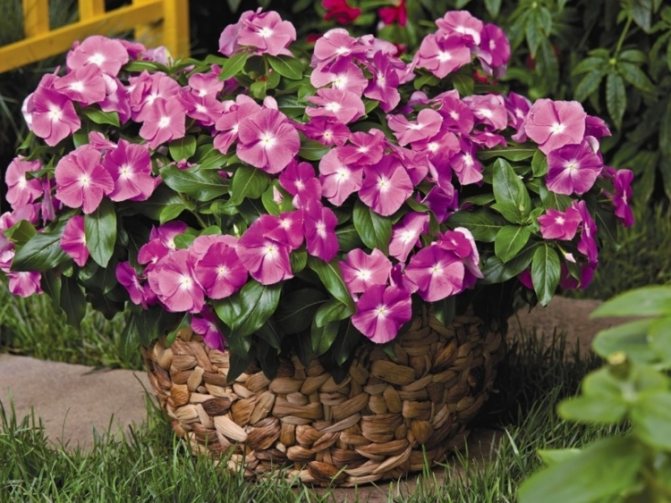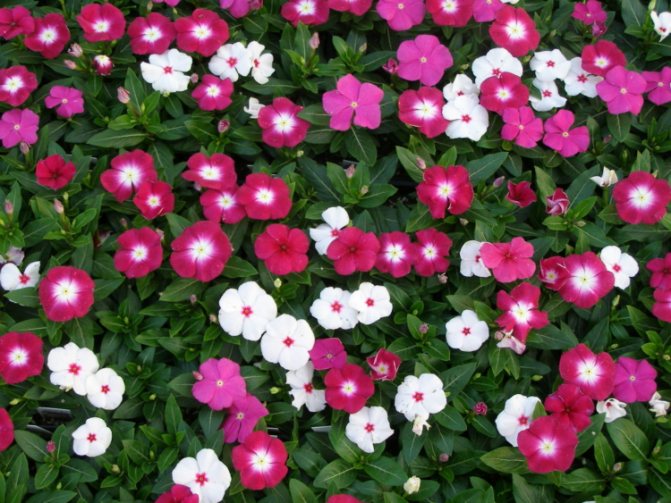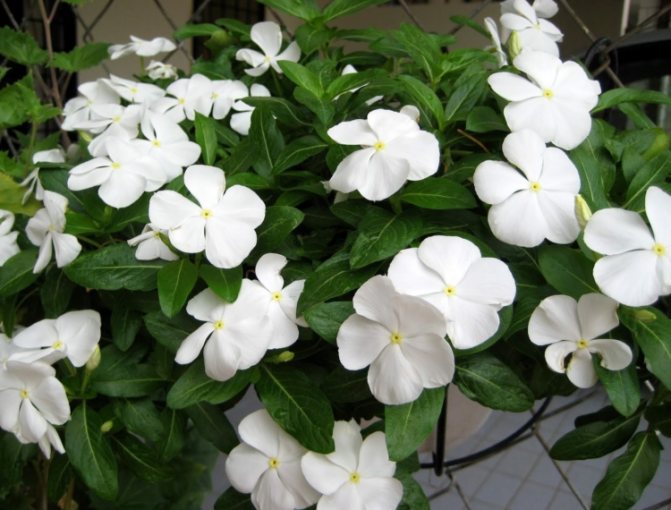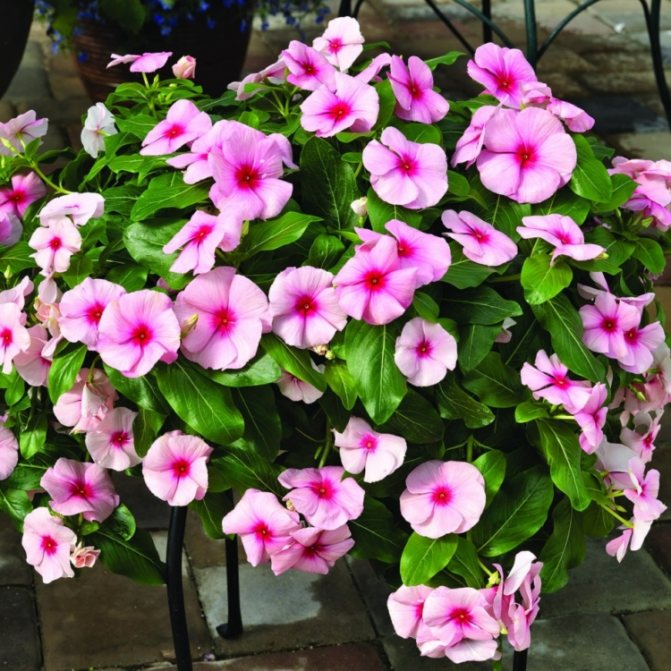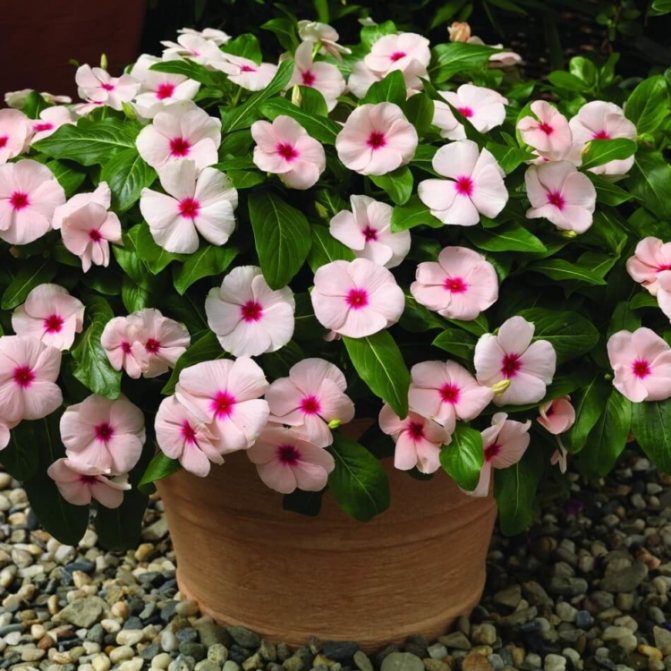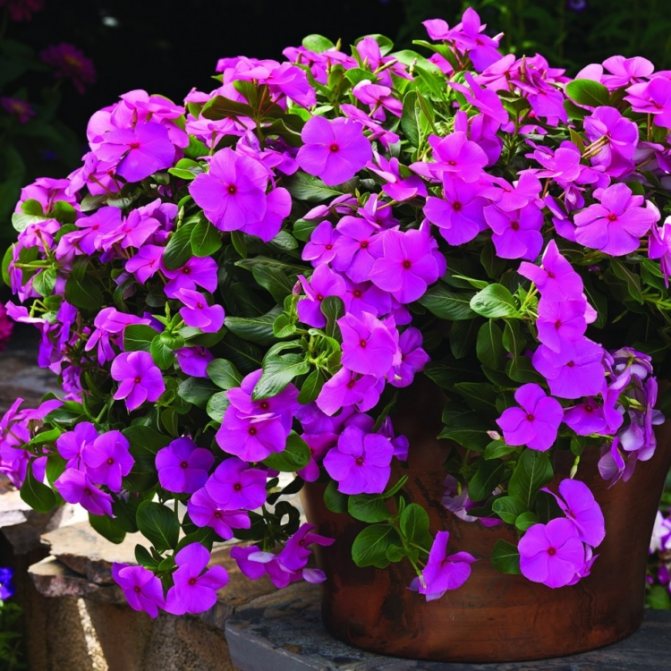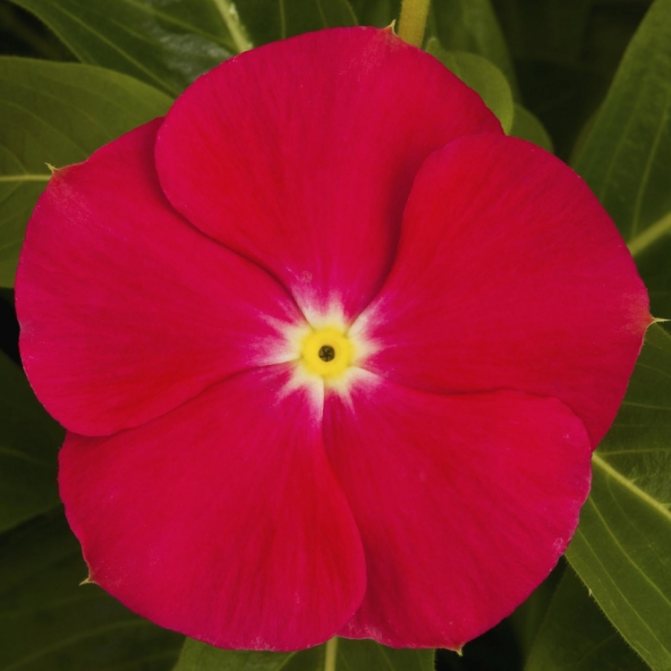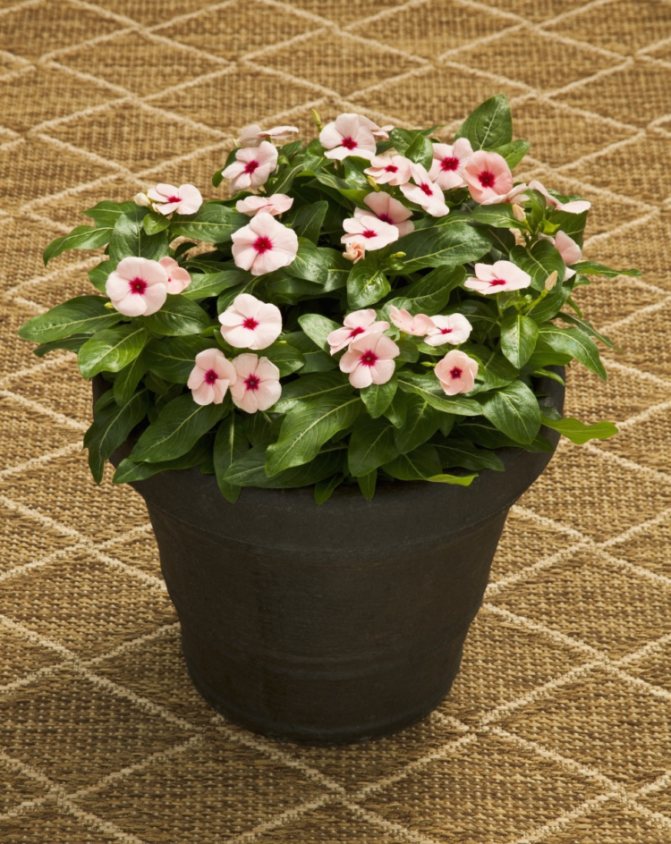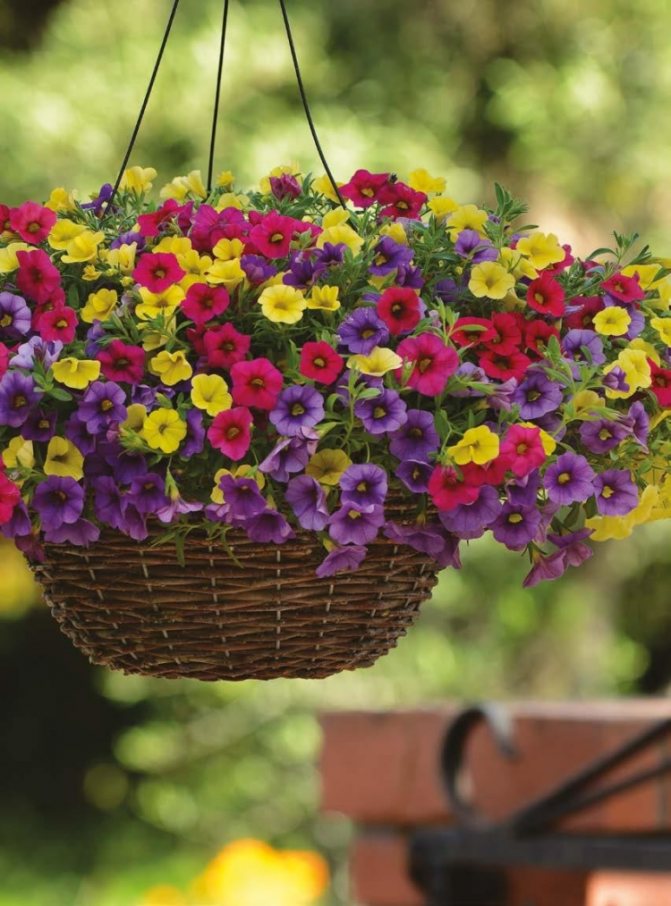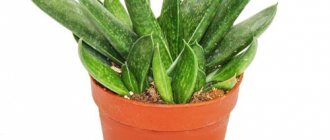Everyone who has seen the catharanthus houseplant will agree that this spectacular bush, strewn with delightful numerous flowers, clearly brings the comfort and warmth of the southern Mediterranean islands to the house. Its name is translated from Greek as "pure, clear or flawless flower." In this article, you will read about growing and caring for a catharanthus at home. Many growers consider him the king of indoor flowering bushes, because the catharanthus pleases its owners with endless flowering almost all year round, and requires minimal care from them after planting.
Varieties of catharanthus with a photo
Thanks to the successful work of breeders, many interspecific hybrids of the catharanthus of a wide variety of colors have been created. The most popular ones are combined in a variety series:
- Culer;
- Ocellatus;
- Parasol;
- First Kiss;
- Cascade;
- Pacifica.
Plants belonging to the Culer variety series are lush, strongly branching bushes. Height 0.4 m.
Fresh articles about garden and vegetable garden
Pepper seedlings do not grow, stands still what to do?
If the cucumber seedlings are very stretched, what to do?
Planting peas in spring sowing: when to sow, how to plant correctly?
The most popular varieties:
- Grape Cooler. The flowers are lavender pink, the eye is pink.
- Pepermint Cooler. The flowers are white, the eyes are red.
- Red Cooler. The flowers are red.
In the First Kiss series, small varieties are combined with flowers up to 5 cm in diameter.
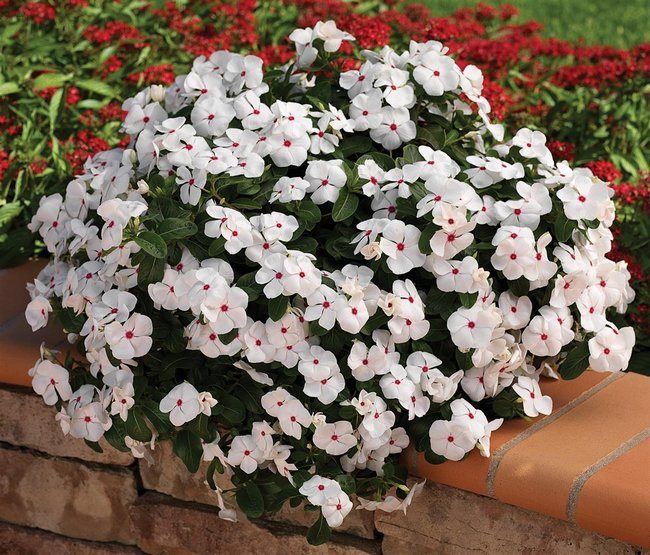
Description
The catharanthus flower belongs to the evergreen herbaceous and subshrub plants of the Apocynaceae family. In the wild, it can be found everywhere in countries with a tropical climate. These are Cuba, Java, Africa, Indochina, Indonesia - not to list everything. It is not possible to accurately determine his homeland, although many scientists tend to Madagascar, where he is most often found. There are seven or eight of its types. In the subtropics, the catharanthus grows up to one and a half meters in height. At home, this bush does not exceed 60 cm. As a houseplant, the catharanthus has been bred since the middle of the 18th century.
For a long time, the catharanthus was considered one of the varieties of another flower - pink periwinkle. These plants are very similar. Both belong to the Kutrov family. Only since 1937, after lengthy disputes, botanists began to attribute the pink catharanthus (Catharanthus roseus), as a species of evergreen perennial dwarf shrubs, to a separate genus of Catharanthus.
The indoor flower catharanthus is a perennial plant often grown as an annual. In height at home, it grows no higher than 50 - 60 cm. Its erect stems are fleshy, branch out at the tops, lignify over time. The roots are powerful, pivotal. The central root reaches a depth of 20-30 cm, there are many lateral adventitious roots with a strong specific odor. Young roots have no root hairs. The leaves of the catharanthus are oblong, pointed at both ends, and up to 7 cm long. They are glossy, dark green in color, with a white longitudinal vein. During flowering, the bush is covered with many wheel-shaped flowers. Catharanthus flowers are 3 to 5 cm in diameter. They have the regular shape of five petals with a flat corolla, the pharynx of which is covered with thyroid hairs.In the center of each flower there is a peephole, usually of a bright contrasting color. There are hybrids with white, orange, light lilac, blue-violet petals. Catharanthus flowers are very similar to phlox flowers, but they are single, and in phlox they are collected in inflorescences. But, during active flowering, from May to October, such a magnificent hat is formed from separately flowering flowers that the decorativeness of the flower at this time is above all praise. Long flowering ends with the onset of cold weather. After flowering, the fruit of the catharanthus is formed, which is a sickle-shaped two-leaved plant, inside which about a dozen elongated seeds are formed.
Healing properties
The catharanthus plant is valued not only for its spectacular appearance and decorativeness. Its medicinal properties have been known for a long time. Healers and healers in Madagascar and Indonesia used catharanthus to treat diabetes, cough, and various tumors. The green parts of the plant contain up to 60 biologically active alkaloids. Modern research has shown that indeed this flower contains substances that lower blood sugar. And the alkaloids vinblastine and vincristine formed the basis of anticancer drugs that are used in modern medicine. All kinds of infusions and decoctions are prepared from the leaves and shoots of the catharanthus, which treat many diseases, such as:
- poorly healing wounds and trophic ulcers;
- fibroids, polyps, prostate adenomas;
- diseases of the teeth and gums;
- broncho-pulmonary diseases;
- hypertension and diabetes.
It is important to know that all parts of the catharanthus are poisonous. It is not recommended to prepare any medicine from it yourself! Side effects, allergic reactions, burns may occur. There are contraindications. It is possible to use preparations from catharanthus only under the supervision and on the recommendation of doctors.
What methods of breeding catharanthus exist
Wishing that periwinkle or catharanthus flaunt in the garden or on the windowsill: the cultivation must be carried out correctly. You can buy young culture in the store. Or try to propagate it yourself. It's not difficult at all, so even a beginner can handle it.
There are such breeding options for periwinkle:
- Seminal. The choice of seeds of this culture is quite wide. They look large, dark brown in color. The seed usually sprouts in a week. The planting takes place in early spring.
- Cuttings. This method requires a catharanthus. A stalk is cut from the top of it and immersed in water. The procedure is carried out in the spring. In good weather, the shoots quickly give rise to roots. Then they are planted in the ground.
- By dividing the bush. Mature plants lend themselves well to division. Separated bushes grow quickly and adapt to a new location. They keep the parcels at home or on the street.
Popular species and varieties
The genus of catharanthus consists of 8 species and several decorative varieties. Mainly cultivated pink catharanthus. It is a small branched bush with greenish, oblong leaves and five-petalled flowers of snow-white or all kinds of shades of pink.
Burgundy
A low, lush blooming bush (up to 40 centimeters). Flowers - medium size, with 5 petals, crimson, with a light center.
Pacific White
Compact lush bush up to 25-35 centimeters high. Against the background of dense foliage, there are white five-petal flowers with a red eye in the center.
Epricot
This catharanthus has cream flowers with a raspberry center. The bush grows up to 35 centimeters in height.
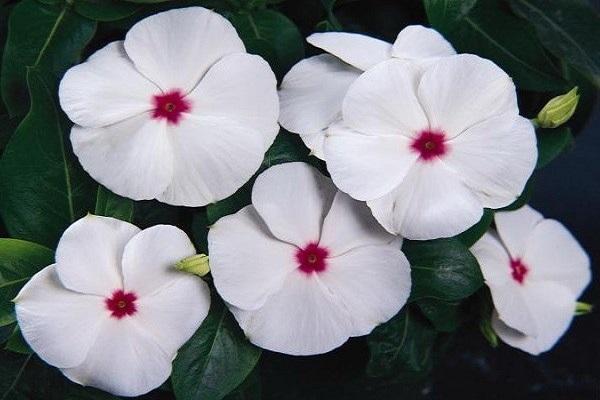

Ice pink
The catharanthus has small pale pink flowers with a red eye. The bush is compact, up to 35 centimeters in height.
Grape Cooler
A low bush with oblong shiny greenish leaves. Flowers - light pink, with a crimson center.
Peppermint Cooler
Snow-white flowers with a bright red center.The branching bush reaches 40 centimeters in height.
Red Cooler
Catharanthus with bright scarlet flowers. The diameter of one flower is up to 5 centimeters.
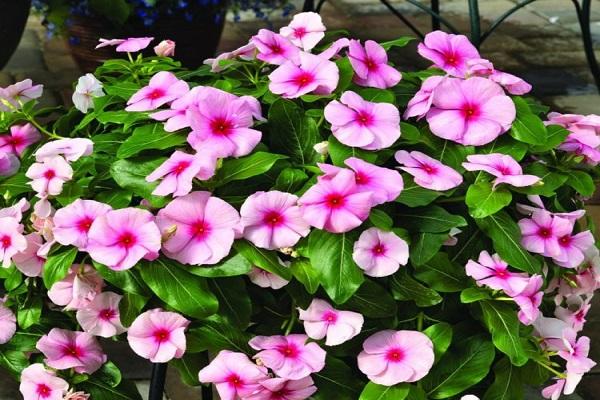

First Kiss Bluebury
Bush 35-45 centimeters high. Flowers - lilac with a dark center.
Cascade
Ampel catharanthus with flowing shoots. This lush bush has stems up to 75 centimeters in length. Leaves are small, oblong, rounded at the end. The whole bush is strewn with delicate, five-petalled crimson or lilac flowers with a white center.
Titanium
Ampel culture with stems up to 75 centimeters long. Flowers - five-petal, red.
Deep Rose
Pink catharanthus with 5-petal, medium-sized flowers. The bush is compact, up to 40 centimeters in length.
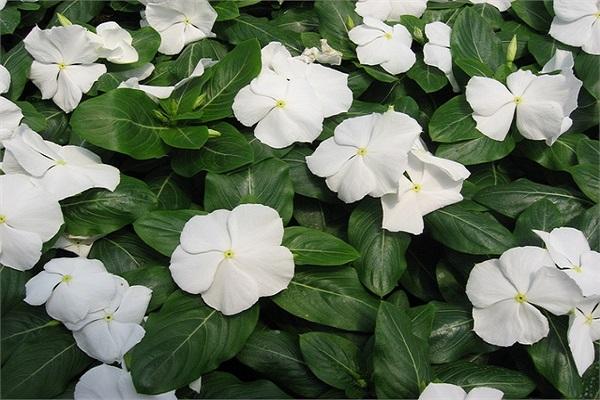

Grape
This culture has lilac flowers with a pink eye. The plant itself is low (up to 40 centimeters in height).
Ed
A plant with a lush bush, abundantly strewn with red flowers. The height of the culture is 30-40 centimeters.
First kiss
Abundantly leafy, branching bush 30-40 centimeters high. It has oblong, shiny, dark green leaves and delicate flowers up to 6 centimeters in diameter. The petals are light at the edges, the middle of the flower is darker. Flowers can have a lilac, coral hue.


Stages of planting a catharanthus from seeds
It is necessary to sow seeds in compliance with all the rules, step by step performing all the stages of the conduct. The fewer mistakes are made initially, the better the result will be in the end:
- Fill the planting containers with the prepared disinfected substrate.
- Water liberally and allow moisture to absorb.
- Smooth and compact the surface.
- Spread out the seeds, keeping a distance of 2 cm between them and press down a little to the ground.
- Sprinkle on top with a layer of soil 0.5 cm.
- Moisten evenly from the top with a spray bottle.
- Cover the containers with a transparent lid, which will create its own microclimate inside for seed germination.
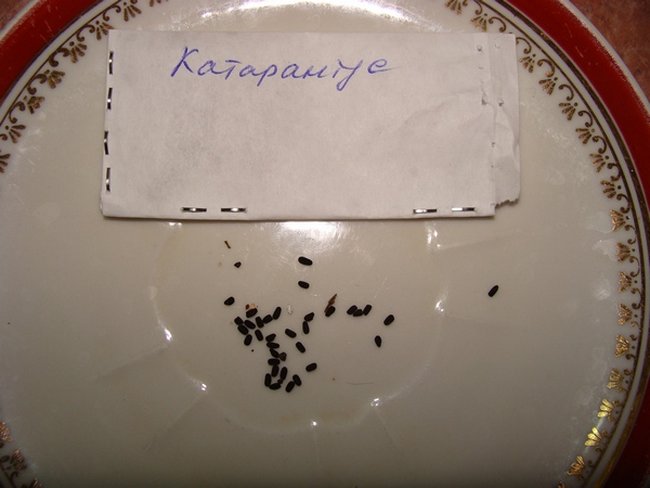

When growing catharanthus using peat tablets, you must initially soak them in water 10 minutes before the start of the procedure. It is necessary to plant the seeds one at a time, deepening into a tablet by 0.5 cm.In the future, put everything in a common tray and cover with foil. For successful germination, it is necessary to put the containers with seeds in a dark place at a temperature of 25 degrees until the sprouts appear.
Landing in open ground
Catharanthus is a thermophilic culture native to the tropics, cultivated in Europe as a houseplant. True, in summer, a flower can be planted in a flower bed. Before planting a catharanthus, you need to choose a suitable place for it. The plant prefers sunlit areas or partial shade. You can plant a catharanthus near a pond or by a fountain.
When to plant
The plant is planted on a flower bed when the temperature rises to 20 degrees Celsius. Seeds are sown in the garden in mid-May, and ready-made seedlings are transplanted only at the end of May. Seedlings are prepared in advance: the seeds are sown in boxes with a substrate in March.
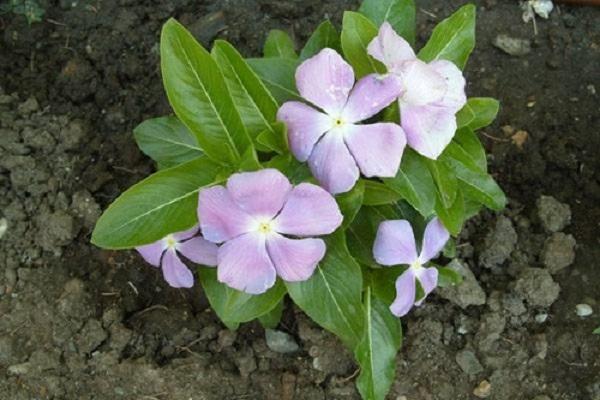

Seed preparation
The seeds are soaked in water with a growth stimulator for 23 hours. Then it is etched in potassium permanganate for 30 minutes. Then they are dried and sown immediately on a flower bed or in boxes with a substrate for seedlings.
Soil requirements
Catharanthus can grow on loam and sandy loam non-acidic soil. 3 weeks before planting, it is recommended to dig up the soil, dilute it with sand and peat, and fertilize with rotted humus. For catharanthus, garden, leaf or sod land is suitable. At the bottom of the flower bed, it is advisable to pour some stones or expanded clay for drainage. In too swampy soil, catharanthus can rot. The soil should not be acidic; to normalize acidity, a little ash can be added to the soil.
Landing scheme
The seeds are poured into shallow grooves at a distance of 3 centimeters from each other, and sprinkled with earth 1 centimeter thick. Then the plantings are watered, covered with a film, after a week the seeds germinate. The grown seedlings are thinned out, leaving larger shoots. If pre-grown seedlings are transplanted into a flower bed, then for each plant a separate hole is prepared to the depth of a glass or pot in which there is a small bush. The plant, together with a lump of earth, is planted in a hole. Be sure to keep your distance. There should be a distance of at least 25 centimeters to the neighboring flower.
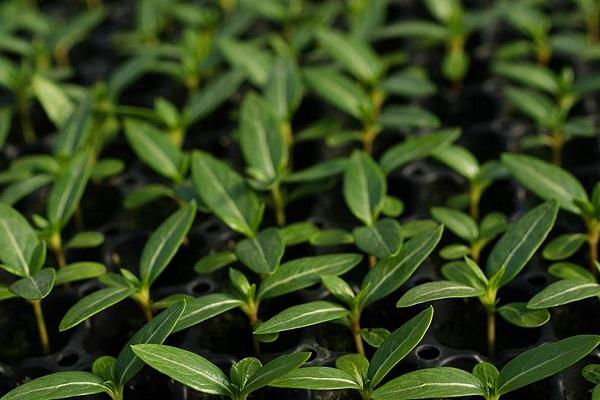

Watering the catharanthus
Katarantus is a tropical inhabitant who loves warmth and moisture very much. But watering should be such that water does not stagnate in containers with soil if the plant is grown in flowerpots or boxes.
Lack of moisture, like overflow, negatively affects the growing season and budding of the plant. In drought, the leaves begin to curl at the catharanthus, the flowers become small. With high soil moisture, it slows down growth, the catharanthus can shed flowers. If the soil is very dense, then the constant presence in moist soil can cause the death of the dwarf shrub. To avoid stagnant water in flowers, you should plant them in pots or boxes with drainage through which excess moisture will be drained.
Do not forget that the plant is very fond of moist air and spraying with warm water. It is recommended to do this procedure often, it is especially important to moisturize the leaves for those plants that are grown in the apartment.
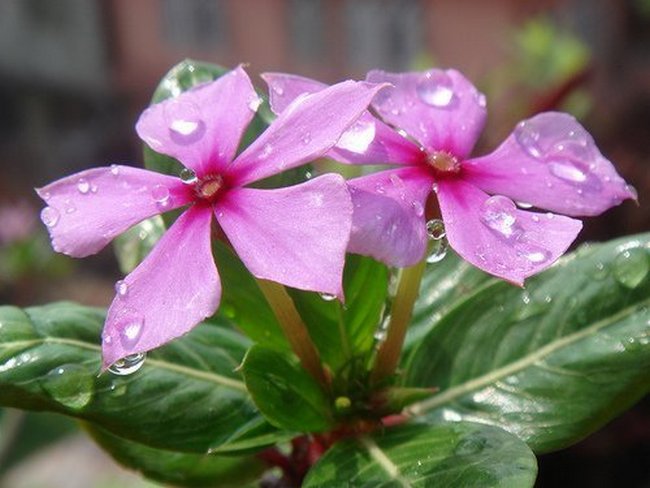

Possible growing problems
You can always determine by the appearance of a plant: is it healthy or something is wrong with it. By its appearance, the catharanthus itself signals the unfavorable conditions of its detention. You need to monitor the plant, and, if necessary, take measures to correct your mistakes.
Let's consider the most common problems of growing a catharanthus.
Diseases
- Small dark bumps or specks appeared on the upper surface of the leaves. On the bottom - something in the form of pustules. These are signs of a disease of many indoor flowers - leaf rust. The reason is the frequent waterlogging of the soil at high humidity. Or, when replanting, heavy or rust-infected soil was used. Treatment is carried out with fungicides (read about diseases of indoor flowers). Transplant the treated plant into new soil.
- The leaves on the shoots became lethargic, turned yellow and fell off. This happens if the pot is on a windowsill unprotected from the sun. Place the flower in the back of the room or protect it from direct sunlight with blinds or curtains.
- The tips of the leaves turned yellow. This happens when the humidity in the room is too low. In winter, this is due to central heating. The pot must be placed in a high pallet with damp expanded clay and set aside from the heating devices. A wide container of water can be placed next to the flower. If there are no flowers on the catharanthus, its leaves should be sprayed with settled water at room temperature. All this should increase the humidity in the room. The tips of the leaves of the catharanthus will stop turning yellow.
- The lower leaves on the shoots turn yellow and fall off. This is a natural process for the catharanthus. Remove them regularly from the plant so that the decorative effect of the flower does not suffer.
- There are few flowers on your catharanthus. Poor flowering usually occurs if the catharanthus is cold. Move the flower pot to a warmer, lighter place - and it will thank you with abundant flowering.
- Leaves begin to turn yellow, flowering stops. Examine the flower pot. If it is not large, if the roots of the catharanthus appeared from the drainage holes, it means that your pet has become cramped in this pot and it is time to transplant it into a wider and deeper pot. A little time will pass, and the plant will come to life and begin to bloom.
- Katarantus began to shed the buds. This happens when there is insufficient attention to the flower: poor lighting, lack of moisture in the soil, or when the air humidity is low.
- Young leaves are falling from the tops of the shoots. Perhaps you rarely water the flower, it does not have enough moisture. At the same time, check other nuances of care: is it warm, light, and whether any insects bite him.
Insects are pests
Sucking parasites like aphids, scale insects and spider mites like catharanthus juice. They can get into your apartment with a new flower from a store, fly in from a neighbor's balcony, or just with a street breeze through an open window. Therefore, check your pets regularly. If found, rinse off the parasites first in the bathroom under the shower. Most of them will wash off with water. Then take a brush, soak it in alcohol and try to gently remove the remaining pests with it. After that, it is advisable to spray the leaves of the catharanthus with soapy water. If the disease is running, and there are too many insects with their eggs and larvae, use special preparations - insecticides, such as aktara, actellic or fitoverm. Carry out the processing two to three times in 7 to 10 days until the complete destruction of the pests. Read the instructions for use carefully on the packages.
We introduced you to the indoor catharanthus flower. Believe me, you will spend less time caring for it than reading this article! This is a completely unpretentious plant, but so sweet and responsive to any attention to it from the florist. The good thing about Katarantus is that this small, compact bush blooms profusely with bright acrylic flowers from spring to October. At the same time, it grows rapidly and multiplies easily. Knowing the simple rules of caring for it, you will always have a grateful plant in your home, ready to decorate the interior of your home all year round.
Top dressing of the catharanthus
In order for the flowering of the catharanthus to be long and plentiful, it needs constant, fairly intensive feeding. If your flower is an annual, it is fed once a week by adding liquid fertilizer for flowering houseplants to the water for irrigation. Liquid fertilizer is suitable for indoor roses. But do not overdo it, read the doses on the package. If the catharanthus after flowering will persist as a perennial, its strength must be preserved. Therefore, feeding should be done less often during flowering, once every 2 weeks, and in a dose reduced by half. After flowering, from October to February, feeding should be stopped altogether.
Features of growing at home
Catharanthus love water. You should always remember this and not leave the flower for a long time without watering. In the heat, the bush can be sprayed with water. It is advisable to transplant it into a larger pot once a year. In the spring and summer, the catharanthus is given complex feeding for flowering plants. In early spring, the stems are slightly shortened. For the summer, flower pots can be taken out on the veranda or outside.
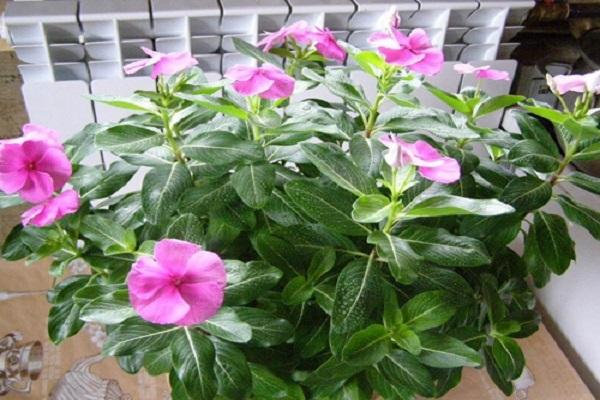

Pruning catharanthus
In the spring, it is necessary to cut off the shoots of the wine by 1/3. This allows the plant to rejuvenate and form a compact bush. If the catharanthus is too stretched out in the summer, then additional pruning can be done again. The cut stems will bloom not earlier than in 2-3 weeks. Although periwinkle in indoor growth is a perennial, it is still better not to keep one plant longer than 3 years. It is better to completely renew it with the help of cuttings, because young plants look much more attractive. Katarantus, which "lives" in the flowerbed, must also be cut off. After all, pruning stimulates the branching of the plant, and the more branches-stalks there are, the more bushy the wine will be and the more flowers will be formed. It should be noted that the breeders took care of the appearance of the bred hybrids and in modern varieties branching is laid down at the genetic level.
Medical use
Catharanthus contains 65 different alkaloids. Most of them are in the roots. Alkaloids have antitumor activity. Leaves and stems are used to treat malignant neoplasms. They make tinctures, decoctions, extracts. Raw materials are harvested closer to September, during the period of seed ripening. Leaves and shoots are dried in a dark and hot place. Dried herbs are used for the first year, then they lose their medicinal properties.
With the help of catharanthus, leukemia, cancer of the breast, uterus, sarcomas, varicose veins, stomach ulcers, and prostatitis are treated. The plant normalizes blood sugar levels, lowers blood pressure, cures psoriasis, and is used as a pain reliever. For treatment, well-dried raw materials are used, since fresh leaves and stems are very poisonous.
Why catharanthus does not bloom
One of the reasons why the catharanthus does not bloom may be a lack of space in the pot, depleted soil. Transplanting and regular feeding will correct the situation. In the wild, the flower slows down its growth during the rainy season due to an excess of moisture in the soil. At home, you need to ensure that watering is regular, the land should not dry out, but the bay of the bush also does not create a comfortable habitat, although the plant is moisture-loving. Lack of light is also the reason for the lack of flowers, since the lush flowering of the catharanthus is possible only in bright light, this is a southern plant accustomed to the abundance of the sun.
What time of year is it better to plant a flower, is it possible in winter?
The catharanthus plant can be grown at any time of the year. However, it should be understood that if the homeland of the shrub is hot and sunny Madagascar, then the warm season will be the most optimal time for growing a crop.
In winter, it is also possible to plant a catharanthus, but it must be monitored even more carefully than when planting it in the spring or summer season of the year.
With proper care, the shrub will delight you with abundant flowering throughout the warm season. In winter, the catharanthus is kept cool - at a temperature of about 14-15 degrees, but care must be taken to ensure that the soil of the plant does not overcool in any way. Usually, watering is slightly reduced. With an excess of moisture in the cold season, the plant can rot the base of the stem.
Catharanthus pest and disease control measures
Catharanthus can be affected by pests such as scale insects, aphids, whiteflies, and mealybugs. It is not difficult to see them, as the leaves of the plant will be spoiled. White patches and stains will form on them. They will also begin to curl up and dry out. To combat insects and diseases, it is necessary to use insecticide spraying.
Not so often, the catharanthus is affected by leaf rust. Spots form on the leaves - pustules. The cause of the disease lies in the high humidity of the soil or air in combination with a low temperature regime. Another reason for rust is the lack of nitrogen in the soil. To combat the disease, it is necessary to treat the bush with Bordeaux liquid and use nitrogen fertilizer.
How to care for the first time?
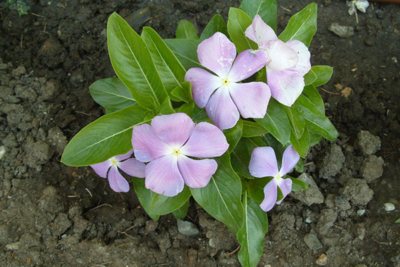

Katarantus is certainly not a capricious flower, however it is possible to achieve lush and long flowering only if certain rules are followed:
- Room temperature in summer is within + 25-26 ° С.
- Winter temperature regime + 14-17 ° С.
- Temperature + 10 ° С is critical for the plant.
- Tropical shrubs love light, but during hot periods you need to be careful with the sun's rays.
- In addition to lighting, watering is also important. The soil should not dry out completely, the plant prefers a moist growing environment.
- It is necessary to have humid air in the room.
- For cultivation, light, loose soil, without excess salt, is suitable.
- In the spring-summer period, feed exotic mineral fertilizers based on phosphorus and potassium.
- Use fertilizer every 2 weeks.
- In the autumn-winter period, top dressing should be completely excluded.
Katarantus on the street
This plant is very fond of warmth. Severe winters, in which the air temperature drops to minus marks, the plant on the street will not survive. It is because of this that the catharanthus is most often planted in pots or hanging pots, which can be easily transferred to a warm room for the winter. Plants are very fond of light, so it is best to place containers with shoots in open and sunny places that are well ventilated.
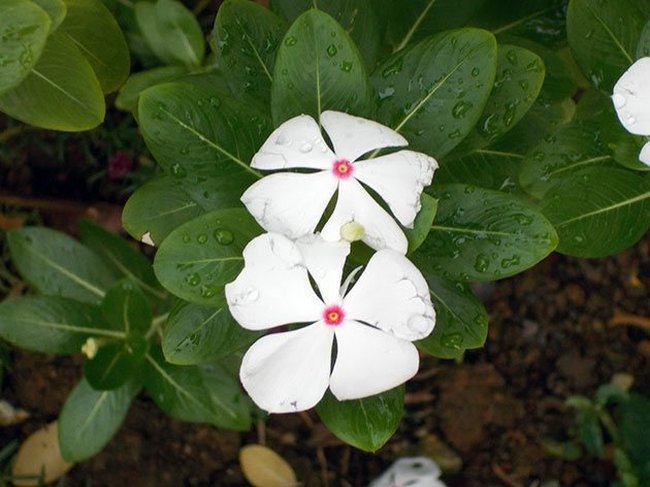

If shrubs are planted directly in the ground, you need to know that it is not recommended to plant lush plants close to each other. Dense foliage completely covers the soil, which later becomes difficult to loosen. And in rainy weather, the soil under a dense carpet of flowers becomes moist and viscous, which disrupts root gas exchange. It is best to leave 30-40 cm between young seedlings when planting. During the period of growth and vegetation, the bushes of the plants will become lush and bald spots on the ground will gradually disappear.
Organization of wintering
If you plant your indoor flower in a flower bed in the country for the summer, then you need to think about how to keep the catharanthus in winter. After all, your sissy will not survive the winter, even a mild one, on the street. Dig up the plant carefully in early October. Cut off the branches two-thirds of the way. Place the flower in a large pot to accommodate the entire root system. Fill the pot up to the top with a mixture of sand and earth. Bring to a cool room with a temperature of 15 - 17 degrees. Try to find one for wintering in an apartment. Let him stand there until spring and warmth. There is no need to water it in winter. When the air outside warms up above 18 degrees, you can plant the rhizome of the catharanthus again on the flower bed.
How to grow flowers and their benefits
Even an inexperienced florist can grow a catharanthus... The main thing is to follow the basic rules for breeding and planting. If everything works out in this, then after a few months you can contemplate a magnificently flowering plant. Exot is propagated as an indoor flower (perennial) or for open ground (annual).
Catharanthus is bred in three ways:
- seed;
- vegetative;
- division of rhizomes.
Sowing seeds
First of all, you should stock up on seed. It is sold in stock at any gardening store. However, before buying, you should pay attention to the freshness, packaging time.
Seeds are sown in late February - early March.
- Before sowing, the seeds are soaked in an aqueous solution of the Epin preparation for 24 hours.
- Then seeds are carefully planted in the prepared, room temperature soil.
- The depth of immersion of seeds is not more than 1 cm.
- From above, the soil is sprayed with water from a spray bottle.
- The planting container is placed in a mini greenhouse or simply covered with a transparent material (film, glass).
- Maintain the temperature at least + 25 ° С, ventilate daily.
- After 7-10 days, you will see the first seedlings, then the shelter can be removed.
- When 3-4 leaves appear, the young plant should be dived.
Seed propagation method is low cost, because the cost of a bag of seeds is ten times lower than that of a grown individual, not to mention the independent receipt of seed. This method is also characterized by a high percentage of germination. From fast-growing seedlings, a flowering plant is obtained by the beginning of summer.
Read about how to grow a catharanthus from seeds at home in our material.
We watch a video about sowing seeds of Katarantus:
Cuttings
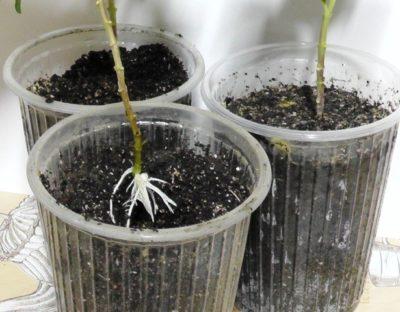

The method is carried out in early spring after the circumcision procedure. Strong processes from the crown, 10 cm long, are left. The leaves are removed, leaving 2-3 pieces on top. We process the cut with Kornevin powder.Then it is placed in a peat-sand mixture and covered with a transparent cap, creating a greenhouse effect.
Rooting will accelerate bottom heating... The cuttings are regularly sprayed and watered with water, not forgetting to air the greenhouse. After 1 month, the roots hatch, and the seedlings should be transplanted into a new pot with high-quality soil.
Thanks to the method of cuttings, you can get a new plant identical to the mother.
We look at the video on how to properly cut a catharanthus:
Dividing the bush
This process is carried out when the plant is transplanted into a new pot. It is preferable to choose a healthy, adult individual. Depending on the size of the root system, the flower is divided into 2-3 parts..
- We remove the flower from the pot.
- We remove excess land.
- We decide on the places of future cuts.
- Separation is performed with a sharp disinfected instrument.
- We treat the sections of the cuts with an antiseptic, it can be crushed activated carbon.
- We plant the plants in various containers.
This method is good because we get the plant already an adult, they quickly adapt to the new soil and grow.
Care features: temperature, watering, feeding
Katarantus loves warmth. At a summer temperature of + 27-28º, the bushes branch out, emitting an abundant color. Temperatures below + 10º are fatal for this plant. If the catharanthus is grown as a perennial plant in a room, it is better to put it outside (balcony, terrace, garden) in the summer.
The flower is light-requiring. In an apartment, it is better to put it on a window from the east or west, and outdoors in a well-lit flower bed, possibly with light shading. The catharanthus should be taught to direct sunlight gradually to avoid leaf burns.
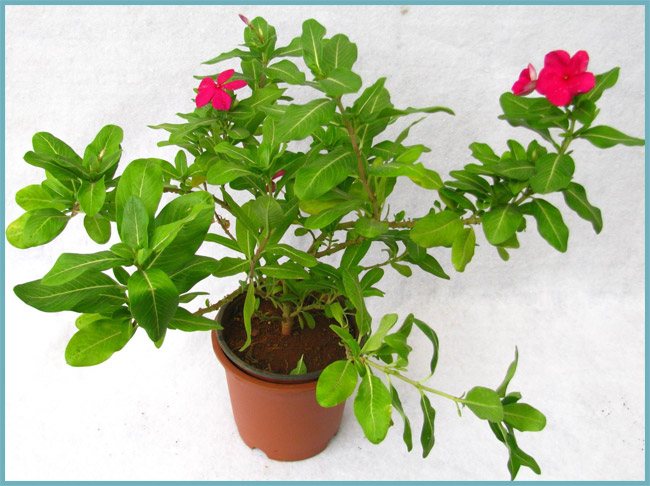

In a room with a constant temperature, the catharanthus will grow for many years.
Watering the flower is required abundant all year round. The earth coma should not be allowed to dry out and, at the same time, there should be no stagnation of water in the sump. Katarantus is very picky about air humidity, so it responds well to regular spraying. Rainy weather, when growing a catharanthus in the garden, contributes to a delay in its development. In order to somehow help the plant survive the rainy season, plantings should not be thickened.
Fertilize the catharanthus every 10 days. In any flower shop, you will be offered balanced feeding. You need to start feeding at the time of the first flowering. Katarantus grows rapidly and constantly needs transplanting into larger pots.
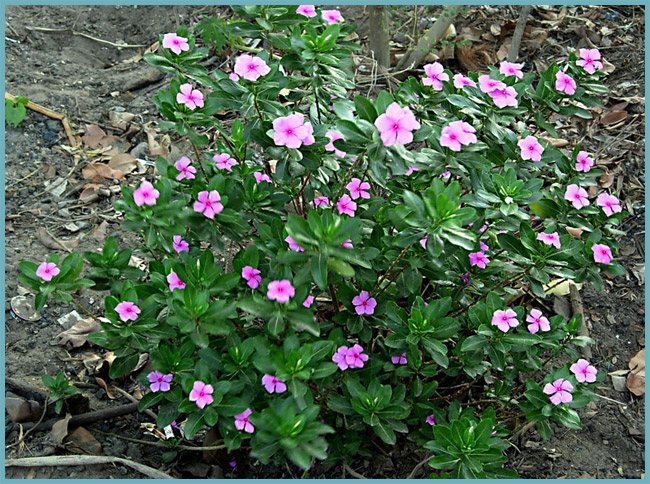

Feed your crop with mineral compounds
For a catharanthus sown in open ground, cultivation and care consists in timely watering, dressing and pruning.
Advice! In the spring, cut off all the stems of the catharanthus. So your flower will grow quickly, there will be no bare trunks, the bush will be lush and covered with flowers.
Katarantrus: photos
Temperature
In summer, the catharanthus will feel comfortable at 20-25 degrees. In winter, the temperature of the content should be reduced to 15-18 degrees.
It is important to know that the catharanthus is afraid of drafts, therefore, when airing the room, it is better to remove it away from the window.
Since the catharanthus is a representative of the tropics, a strong drop in temperature is destructive for it. Therefore, in winter, the temperature should not drop below 8 degrees.
Katarantus loves fresh air, therefore, when the weather is warm outside, it can be taken out to the balcony, loggia or garden... In this case, it is necessary to choose a place protected from the scorching rays of the sun, rain and drafts. With the first cold snaps in August, the plant should be taken into the house.
The flower tolerates temperature fluctuations relatively well, but it is better to provide it with the most comfortable conditions. Then he will delight with abundant lush flowering.
Humidity
Katarantus prefers high humidity of the environment - not less than 60%... To provide such conditions, you can use several methods:
- Place containers with water around the flower;
- During the heating season, put a damp cloth on the radiators;
- Use a humidifier;
- Place the pot in a tray with damp filler - sphagnum moss, pebbles or expanded clay.
The approach to spraying the catharanthus should be prudent. On the one hand, the plant loves high humidity, on the other, it is undesirable to get drops on the flowers. During the flowering period, spraying should be done very carefully.
In winter, in a room with dry air, you can spray the resting pink periwinkle every day, in the morning or in the evening. For this, warm, settled water and a fine-grained spray bottle are used.
The soil
To plant a catharanthus, you need a nutritious light soil. You can buy ready-made flowering plant substrate at the store.
When cooking on your own, you should mix sand, peat, turf and humus in equal proportions.
Another option is sod, leafy soil, peat and sand in a ratio of 1: 2: 1: 0.5. Before planting, the mixture should be disinfected by spilling it with a solution of potassium permanganate.
The pot must have drain holes. At the bottom, you need to lay out a 4 cm layer of drainage.
Application
In our cool climate, catharanthus is often grown not as a garden annual, but as a domestic perennial plant. In the summer, it is taken out and hung on balconies, verandas, terraces as an ampelous flower or displayed in pots as a flowering shrub.
Catharanthus looks great in a flower bed in combination with other plants. Neighbors such as petunia, lobelia are optimal for him.
It is often used in the garden as a ground cover. Catharanthus grows rapidly, forming a dense flowering carpet. It can also be planted as a curb along garden paths, certain zones on the site.
Types and varieties
Let's get acquainted with the most common varieties.
Albus
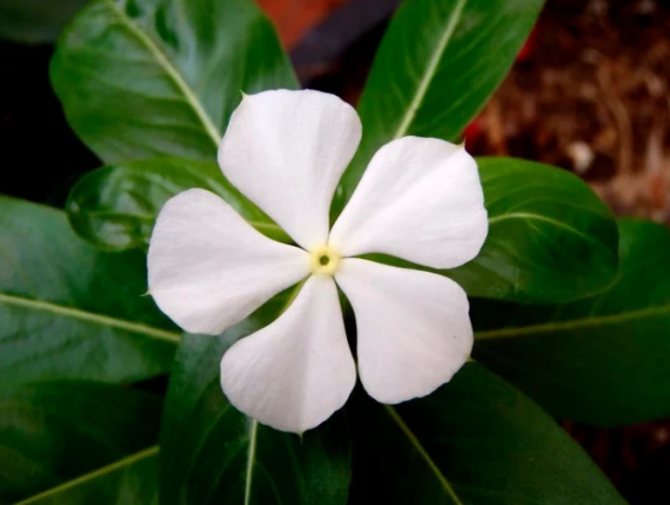

A cute plant with snow-white buds, in the middle, each flower is yellowish. The foliage has a pointed shape, a contrasting white vein.
Cascade
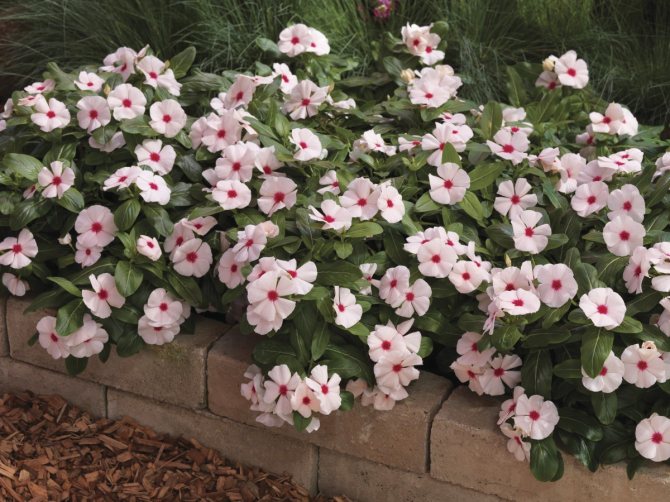

The only ampelous variety among flowering catharanthus. The shoots hanging down can reach one and a half meters. Take care of a sufficiently high hanging planter in advance. The shade of the petals can be different, pink-purple tones are more common.
Ed
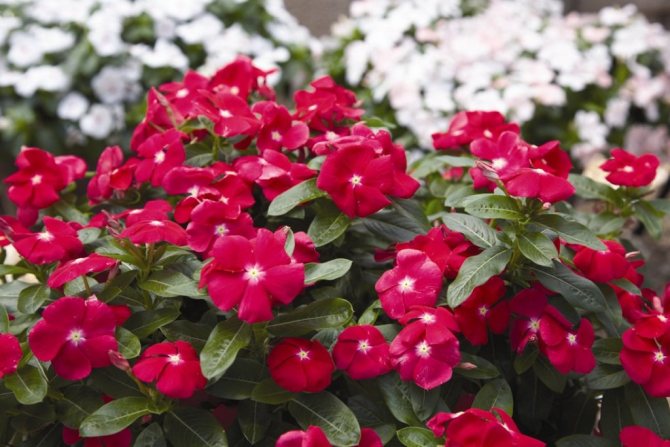

As the name implies, the shade of the flowers in this case is deep red. The bright buds of the plant look very beautiful against the background of dark foliage.
Grape
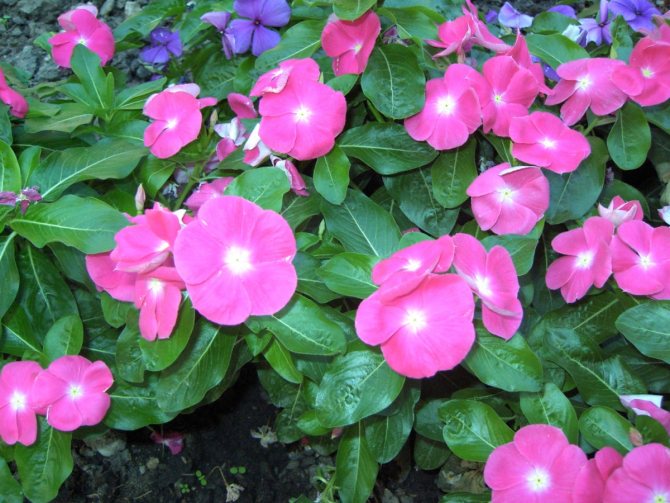

A highly decorative variety with bright purple petals with a pink heart.
4. Varieties:
4.1. Catharanthus ampelous or cascade
Large-flowered varieties specially bred for growing in hanging pots with long, drooping shoots. The stems of the plant hang over the edges of the pot, and the flowering is so abundant that the plant can completely hide the pot with its buds. With proper formation, a large blooming ball is obtained from this species.
↑ Up,
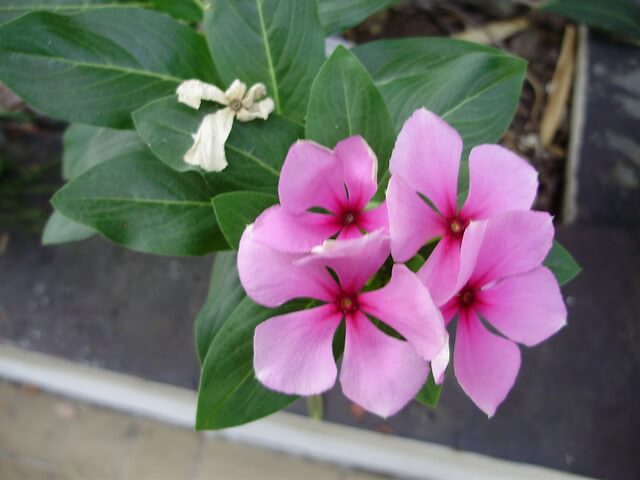

Diseases
Brown rust can affect the catharanthus, which is recognized by the presence of pustules on the back of the leaves.
The damaged parts are removed and the plant is treated with a fungicide such as Fundazol.
Of the pests, aphids, spider mites, and scale insects pose a threat to pink periwinkle.
Pest control can be mechanically removed using a soap solution or insecticide treatment: Aktellik, Fitoverm or Nurell-D.
Prevention of the appearance of insects is proper care, in particular, maintaining high humidity.
Transfer
Periwinkle grows very quickly, so it needs frequent transplants. Young catharanthus require several transfers to new pots over the summer.Those plants that are grown as perennials need an annual spring transplant (in March - early April).
Timely transplantation is the key to good growth and abundant flowering of periwinkle. If the roots braid the entire earthen lump, the buds cease to appear, and the leaves begin to turn yellow and fall off. In view of this, timely transplantation is very important for the catharanthus.
The best way to transplant a catharanthus is transshipment... Due to the fact that the earthen ball and roots are not damaged, the plant quickly adapts to new conditions and continues to grow and develop well.
It is recommended to take a new pot for catharanthus 5-6 cm larger in diameter than the previous one.
A day or two before the transplant, the periwinkle is not watered so that the earthen lump is strengthened. A good drainage layer of expanded clay, clay shards or broken brick is laid at the bottom of the new pot. The plant is moved to a new container, and the free space in it is covered with new soil and slightly compacted.



